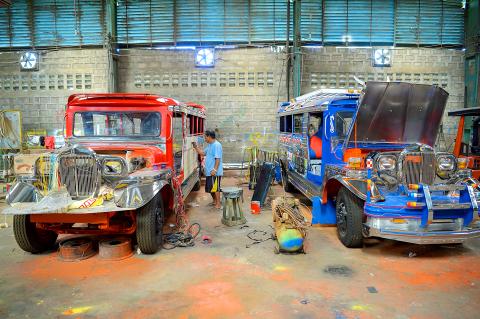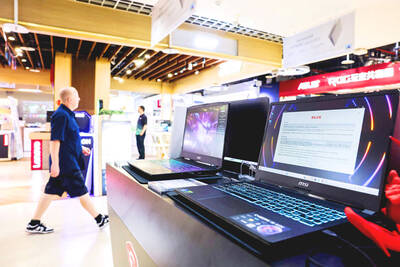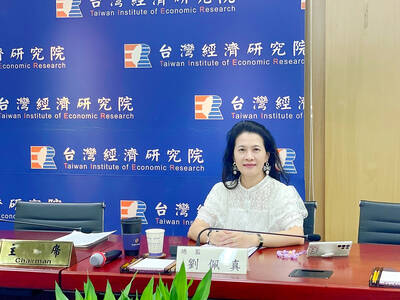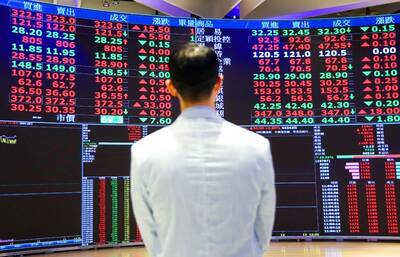Bernardo de la Cruz cast his eyes around the nearly silent workshop where he used to toil overtime hand-painting custom decor on jeepneys, the singularly Philippine minibuses facing the scrapheap. These rolling art galleries adorned with images of everything from Batman to babies, as well as disco lights and chrome wheels, have for decades provided cheap transport for millions.
However, pollution and safety concerns have led to a modernization program, with jeepneys 15 years or older to be taken off the streets by next year.
“This is an act of treachery against fellow Filipinos,” De la Cruz said. “This is a uniquely Filipino product. We were born with it.”

Photo: AFP
When he began 45 years ago, there were hundreds of artists giving the vehicles their famously boisterous paint jobs. Now there are estimated to be fewer than a dozen left.
He has seen orders decline from a high of up to 80 per month in the 1980s to just one or two now.
His canvas is being replaced by eco-jeepneys, powered by electricity or less-polluting diesel engines.
Riders of old jeepneys currently have to climb in through a hatch in the rear, cramming into the benches inside with no respite from the heat and roadside pollution.
The jeepney’s successor has been billed as a big improvement. It has doors, individual seats, air-conditioning and enough height to stand up. However, it is to be mass-produced and look just like a public bus.
Skipping over the jeepney’s bespoke production process in small workshops means a loss of the individual style and flair that made them global symbols of the Philippines.
“It’s one of the most genuine forms of modern folk art that we have,” said Bernie Sim, a Manila-based graphic designer and coauthor of a 2014 book on jeepney art.
French fashion designer Christian Louboutin launched a jeepney-themed handbag collection last year, while Swedish furniture giant IKEA painted a jeepney in its signature blue and yellow to announce plans to open a Philippine store.
However, the vehicles, which were first made from leftover US jeeps after World War II, have been on borrowed time for years.
Jeepneys are highly polluting and the Philippines is desperate to improve air quality in its traffic-clogged cities.
Their drivers are also notorious for ignoring traffic rules and the vehicles have few safety features.
In addition, Manila in 2014 ushered in Internet-based ride-sharing services and three years later Philippine President Rodrigo Duterte said that the jeepney must evolve or disappear.
“They have all but stopped making jeepneys,” 52-year-old jeepney artist Vic Capuno said.
As a result, he and a colleague at Armak Motors Corp now paint just three or four jeepneys each month.
De la Cruz worked on nine in the past year. He is the only painter left at Manila’s Sarao Motors Inc, once the country’s biggest producer.
Two of his siblings were also jeepney artists, but they died from diseases he believes were caused by years inhaling fumes from the paint. Yet, he is still passionate about the vehicle’s importance in Philippine history.
“When the jeepney disappears, a piece of Filipino culture will also die,” De la Cruz said.
A self-taught painter, he was inspired by the work of renowned local artists such as Carlos Francisco and Fernando Amorsolo.
His jeepney designs, still seen on the streets for now, chronicle the rapidly changing landscape of his home — Las Pinas — from a farming and salt-making backwater into a highly urbanized area.
“It’s a pleasing sight. It brings us back to a time and place that is no more,” De la Cruz said.
After raising four children on the pay earned painting, he now also creates canvases and makes storefront signs as a sideline.
He conceded that he could have a decent life without the jeepneys, but was heartbroken by the government’s decision.
“I would like to appeal to the authorities not to outlaw it,” De la Cruz said. “At times I cry quietly when I think about what is happening.”

IN THE AIR: While most companies said they were committed to North American operations, some added that production and costs would depend on the outcome of a US trade probe Leading local contract electronics makers Wistron Corp (緯創), Quanta Computer Inc (廣達), Inventec Corp (英業達) and Compal Electronics Inc (仁寶) are to maintain their North American expansion plans, despite Washington’s 20 percent tariff on Taiwanese goods. Wistron said it has long maintained a presence in the US, while distributing production across Taiwan, North America, Southeast Asia and Europe. The company is in talks with customers to align capacity with their site preferences, a company official told the Taipei Times by telephone on Friday. The company is still in talks with clients over who would bear the tariff costs, with the outcome pending further

A proposed 100 percent tariff on chip imports announced by US President Donald Trump could shift more of Taiwan’s semiconductor production overseas, a Taiwan Institute of Economic Research (TIER) researcher said yesterday. Trump’s tariff policy will accelerate the global semiconductor industry’s pace to establish roots in the US, leading to higher supply chain costs and ultimately raising prices of consumer electronics and creating uncertainty for future market demand, Arisa Liu (劉佩真) at the institute’s Taiwan Industry Economics Database said in a telephone interview. Trump’s move signals his intention to "restore the glory of the US semiconductor industry," Liu noted, saying that

NEGOTIATIONS: Semiconductors play an outsized role in Taiwan’s industrial and economic development and are a major driver of the Taiwan-US trade imbalance With US President Donald Trump threatening to impose tariffs on semiconductors, Taiwan is expected to face a significant challenge, as information and communications technology (ICT) products account for more than 70 percent of its exports to the US, Chung-Hua Institution for Economic Research (CIER, 中華經濟研究院) president Lien Hsien-ming (連賢明) said on Friday. Compared with other countries, semiconductors play a disproportionately large role in Taiwan’s industrial and economic development, Lien said. As the sixth-largest contributor to the US trade deficit, Taiwan recorded a US$73.9 billion trade surplus with the US last year — up from US$47.8 billion in 2023 — driven by strong

STILL UNCLEAR: Several aspects of the policy still need to be clarified, such as whether the exemptions would expand to related products, PwC Taiwan warned The TAIEX surged yesterday, led by gains in Taiwan Semiconductor Manufacturing Co (TSMC, 台積電), after US President Donald Trump announced a sweeping 100 percent tariff on imported semiconductors — while exempting companies operating or building plants in the US, which includes TSMC. The benchmark index jumped 556.41 points, or 2.37 percent, to close at 24,003.77, breaching the 24,000-point level and hitting its highest close this year, Taiwan Stock Exchange (TWSE) data showed. TSMC rose NT$55, or 4.89 percent, to close at a record NT$1,180, as the company is already investing heavily in a multibillion-dollar plant in Arizona that led investors to assume